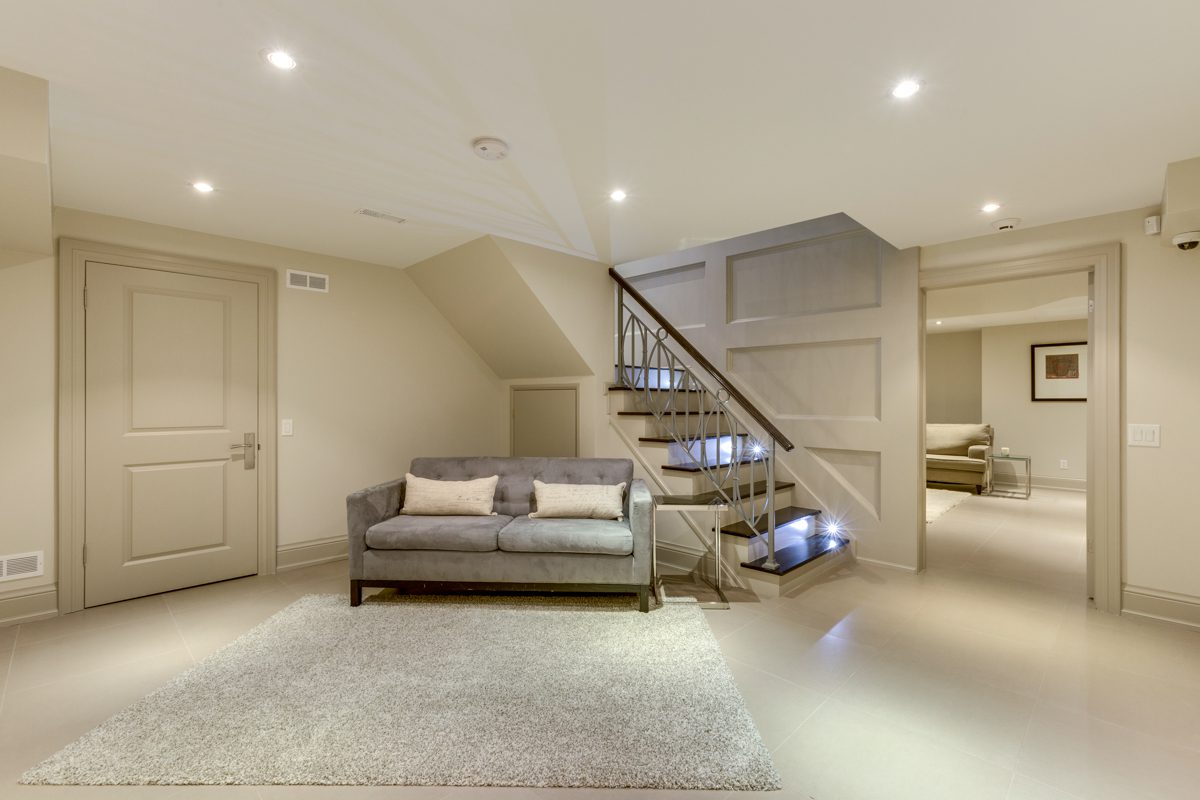The popularity of Torontonians living comfortably in their home while earning an additional income by renting out their basement is on the rise. It offers convenience in affordability for renters that are students, young professionals or seniors. Aside from it being a trend, Ontarians need to be familiar with real estate codes and bylaws before turning a basement into a rental property. It also applies to homeowners renovating an unfinished basement for renters to live.
If you have an interest in purchasing a property with a basement apartment or plan to earn extra income through renovations, this information will help.
Thinking about creating your first investment property? Click here to read our list of Dos & Don’ts of Being a Toronto Landlord.
Basement Apartment Terms to Remember
In an interview with Richard Silver, the Senior Vice President of Sales at Sotheby’s International Realty Canada he stated:
It is important for home buyers to find out if a property is an auxiliary apartment if it is legal and all fire code requirements are met.
As you search for a new single-family home that has a retrofit and legal basement apartment, here is a list of words to remember. The words listed below are used to describe a basement apartment:
- Auxilliary apartment
- Dwelling unit
- In-law suites
- Granny flats
- Two-unit house
- Second suite
Another important point to remember is that a garage in a single family home can be renovated to serve as a basement apartment.
Rental basement apartments are a lucrative business, but they can be a concern to neighbours at the same time. A house that is not legal or retrofit can have an unfit parking space, overflowing garbage and could post a safety concern for all individuals living in the property and the property of neighbours. There are cases where a homeowner purchased property while under the impression the dwelling unit was legal and retrofit, later to find out their home is not fit for the safety of a renter.
So how to make sure you’re in the clear with your basement apartment?
Looking for more tips about real estate investment? You might like these blog posts.
- What Canada’s Home Flipping Tax Means For Sellers
- The Best Toronto Neighbourhoods to Invest in
- 5 Things to Know Before You Buy in Downtown Toronto
THE DEFINITION OF LEGAL STATUS
A basement apartment is considered ‘legal’ if:
- it passes the Fire Code and electrical safety requirements
- the municipality registers the unit
- it follows local bylaws
If you’re thinking of buying a property with a basement apartment, pay attention to online advertisements, contracts or documentation on the specifics of a property with a rental unit in the basement. In reality, almost 80 per cent of all advertised basement apartments don’t comply to the rules and wouldn’t be considered legal.
As Bob Aaron, Toronto real estate lawyer, stated in his article about retrofit:
If a real estate sale listing describes a home with a basement apartment using the toxic word “retrofit” — which applies only to Fire Code — the best thing to do is to find out why the unit doesn’t comply and what would be necessary to legalize it.
Always your realtor to confirm if the property is legal before purchasing a property and request an inspection to confirm this information.
If you’re a home owner and you’re thinking of adding a basement apartment or renting out your not-entirely-legal apartment, here’s what you need to know.
Adding a new unit
The concept of a basement apartment needs to be inline with the Zoning Bylaw which is available at your local City Hall. An application for a building permit needs to be completed and handed in.
If you have a property with a basement apartment, request a Certificate of Compliance from your nearest Fire Department. The certificate is granted after the fire department reviews the home first. You can contact the Municipal Property Standards for this certificate.
The Electrical Safety Authority can help with reviewing your electrical system. If the unit fails inspection, they will give you recommendations for the necessary upgrades. It is the responsibility of the homeowner to complete upgrades before renting the unit to tenants.
- Inspections for fire code compliance cost between $120 and $300.
- Inspections for electrical safety cost $79.
WHAT A BASEMENT APARTMENT NEEDS
The requirements for a basement apartment will depend on your location. There are a few rules that apply:
- Basement apartment ceiling must be 6 feet 5 inches
- Bathrooms require an exhaust fan and a window
- One parking spot for basement renters
- The door needs to be 32 inches by 78 inches
Building code vs. fire code
Building code is a code that applies the day the property was built, it changes over the years, but you don’t have to upgrade your house to comply with the new changes, since the code doesn’t apply retroactively.
The Fire code is a part of the building code, and it prescribes construction and saftey issues related to how the property should perform in the case of a fire. The fire code CAN apply retroactively.
So what does retrofit mean then?
Since the Fire code applies retroactively, that’s where the phrase “basement retrofit” comes from. Once a Fire Code is developed, it applies to all basement apartments, existing and future ones, which means that the owners of existing apartments have to upgrade their properties to comply with the new code.
The Ontario Fire Code was established in 1994. It holds the owner of property responsible for the safety of renters living in their basement. Before the request for a Fire Code in 1994, single-family homes with basement suites built between July 14, 1994, and November 16, 1995, were exempt from the Zoning Bylaw.

Basement Suite
Today, if you’re thinking about adding a basement apartment you have to:
- check the zoning bylaw (Bill 140) at the City Hall Buildings Division to find out if basement apartments are allowed in your area
- if they are allowed, apply for a building permit, keeping in mind that you will have to comply with today’s building codes
The Bill 140 was created by the Government of Ontario in 2010 for the Affordable Housing Act. The bill applies to single family home zoning laws which include a townhouse, detached or a semi-detached house.
What makes a basement apartment retrofit?
A few examples that make a basement apartment retrofit include:
Fire containment
The fire in the unit must be contained long enough to get all the tenants out of the property. That means that the walls, floors and ceiling of your basement apartment should be able to control the fire for at least a couple of minutes.
The usual requirement is that the component lasts at least 30 minutes. According to Carson Dunlop’s report on retrofit, drywall and plaster are acceptable but suspended ceilings are not. You can’t have expoised joists in the furnace room, te celing must be continuous. Any doors should be metal or solid wood, at least 1 3/4 inch thick.

Basement Exit
Means of egress – Escaping the home
There needs to be easy access to exit in case of a fire. If each unit has its own exist, that’s the ideal situation. A shared exit for all units is allowed only if it’s ‘fire separated’ from both units with a 30 minutes rating. If this is not true, you can still use this common exit, but only if there is a second exit from each unit and the fire alarms are connected. Carson Dunlop lists and example:
There is a common exit area but the common area does not have a 30 minute fire separation between both the units. If there is an “acceptable” window for an escape route and the smoke alarms are interconnected, we are all set.
An “acceptable” window means:
- it has a windowsill within 3 feet of grade
- the smallest dimension is 18 inches
- the opening is at least 600 square inches
- if there is a window well on a basement window, it must extend 3 feet out from the wall, to allow enough room to crawl out
Electricity is up to par with safety codes
The owner has to ask the Electrical Safety Authority for an electrical inspection. Any discovered deficiencies must be addressed.
Fire detection
Each unit has to have a smoke alarm. The owner is responsible for making sure that there are smoke alarms and that they’re maintained. The alarms don’t have to be interconnected unless the fire separation to the common exit area doesn’t have a 30 minutes rating. (It has to have at least 15 minutes rating.)
A common mistake home buyers often make is assuming that retrofit means a legal basement apartment. There is a difference between fire code requirements and the requirements of a legal basement apartment.
The owner is responsible to make sure the apartment is up to the above mentioned rules. If the renter or neighbour report the owner for having a basement apartment that is not up to Fire Code standards they can be sent to prison or fined. The fine can be up to $25,000 for an individual and $50,000 for a corporation. Remember that anyone can make a request to the city to have your basement apartment inspected. A tenant has the legal right to request their landlord to bring their dwelling unit up to Fire Code requirements.
Richard Silver explained that a common mistake home buyers make is “assuming that retrofit means a legal basement apartment, There is a difference between fire code requirements and the requirements of a legal basement apartment.”
Remember that while these guidelines are still fairly loosely enforced, enforcement has become stricter over time and it’s only likely to become even stricter.
So remember, just because your basement apartment is retrofit, it doesn’t mean it’s also legal.
Many Torontonians are living the basement rental dream. It is a lucrative business that comes with hard work with long-term benefits. Think of the vacation or personal debt that can be taken care of with the extra income. Not to mention it is a big selling feature if you decide to sell the property one day. Just make sure that the dwelling unit meets the Fire Code, safety code, and legal requirements.
Looking to purchase or build a profitable income property? As seasoned experts in Toronto real estate, our team would be happy to assist you. Click here to get in touch.








